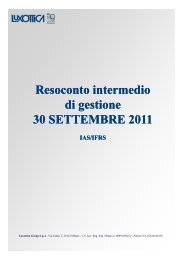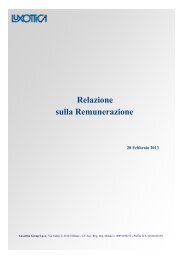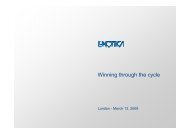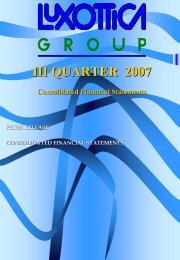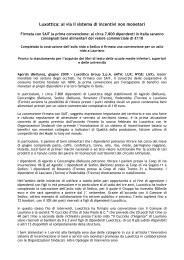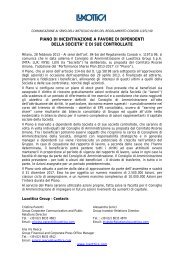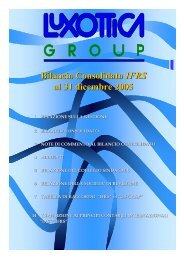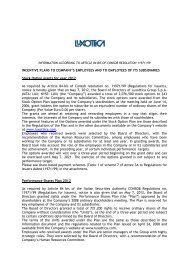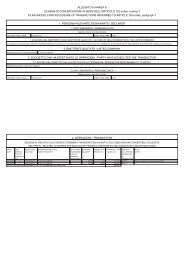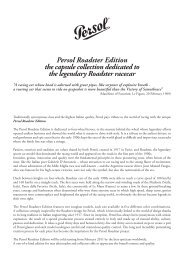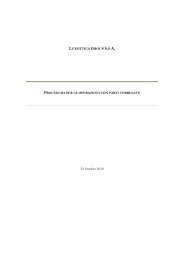ANNUAL REPORT 2004 - Luxottica Group
ANNUAL REPORT 2004 - Luxottica Group
ANNUAL REPORT 2004 - Luxottica Group
Create successful ePaper yourself
Turn your PDF publications into a flip-book with our unique Google optimized e-Paper software.
The Company recognizes forfeitures as they occur for<br />
the years 2002 and 2003 and changing to the<br />
binomial approach in <strong>2004</strong> has assumed a forfeiture<br />
rate of 6% for <strong>2004</strong> grants.<br />
DERIVATIVE FINANCIAL INSTRUMENTS<br />
Derivative financial instruments are accounted for in<br />
accordance with SFAS No. 133, Accounting for<br />
Derivative Instruments and Hedging Activities, as<br />
amended and interpreted (“SFAS 133”).<br />
SFAS 133 requires that all derivatives, whether or<br />
not designed in hedging relationships, be recorded<br />
on the balance sheet at fair value regardless of the<br />
purpose or intent for holding them. If a derivative is<br />
designated as a fair-value hedge, changes in the<br />
fair value of the derivative and the related change in<br />
the hedge item are recognized in operations. If a<br />
derivative is designated as a cash-flow hedge,<br />
changes in the fair value of the derivative are<br />
recorded in other comprehensive income (“OCI”) in<br />
the Statements of Consolidated Shareholders’<br />
Equity and are recognized in the Statements of<br />
Consolidated Income when the hedged item affects<br />
operations. The effect of these derivatives in the<br />
Statements of Consolidated Operations depends<br />
on the item hedged (for example, interest rate<br />
hedges are recorded in interest expense). For a<br />
derivative that does not qualify as a hedge,<br />
changes in fair value are recognized in the<br />
Statements of Consolidated Operations, under the<br />
caption “Other - net”.<br />
<strong>Luxottica</strong> <strong>Group</strong> uses derivative financial instruments,<br />
principally interest rate and currency swap<br />
agreements, as part of its risk management policy to<br />
reduce its exposure to market risks from changes in<br />
interest and foreign exchange rates. Although it has<br />
not done so in the past, the Company may enter into<br />
other derivative financial instruments when it assesses<br />
that the risk can be hedged effectively.<br />
RECENT ACCOUNTING PRONOUNCEMENTS<br />
In December 2003, the Financial Accounting<br />
Standards Board (“FASB”) issued FASB<br />
Interpretation (“FIN”) No. 46, Consolidation of<br />
Variable Interest Entities - an interpretation of ARB No.<br />
NOTES TO CONSOLIDATED FINANCIAL STATEMENTS<br />
51 (“FIN 46-R”) to address certain FIN No. 46<br />
implementation issues. This interpretation clarifies<br />
the application of Accounting Research Bulletin<br />
(“ARB”) No. 51, Consolidated Financial Statements<br />
for companies with interests in entities that are<br />
variable interest entities (“VIEs”) as defined under<br />
FIN No. 46. According to this interpretation, if a<br />
company has an interest in a VIE and is at risk for the<br />
majority of the VIE’s expected losses or receives a<br />
majority of the VIE’s expected gains it shall<br />
consolidate the VIE. FIN 46-R also requires<br />
additional disclosures by primary beneficiaries and<br />
other significant variable interest holders. FIN 46-R is<br />
effective no later than the end of the first interim or<br />
reporting period ending after March 15, <strong>2004</strong>,<br />
except for those VIEs that are considered to be<br />
special purpose entities for which the effective date<br />
is no later than the end of the first reporting period<br />
ending after December 15, 2003. The Company<br />
adopted FIN 46-R on January 1, <strong>2004</strong> and such<br />
adoption did not have a material effect on the<br />
Company’s consolidated financial statements.<br />
In December 2003, the FASB issued SFAS No. 132-<br />
R, Employer’s Disclosures about Pensions and Other<br />
Postretirement Benefits, which requires additional<br />
disclosures in the financial statements about assets,<br />
obligations, and cash flows among other items. The<br />
new required disclosures are reflected in Note 9.<br />
In May <strong>2004</strong>, the FASB issued FASB Staff Position<br />
No. FAS 106-2, Accounting and Disclosure<br />
Requirements Related to the Medicare Prescription<br />
Drug, Improvement and Modernization Act of 2003<br />
(“FSP FAS 106-2”), which supersedes FSP FAS 106-<br />
1. Under the Act of 2003, if a sponsor of retiree<br />
healthcare plans offers drug benefits that are at least<br />
actuarially equivalent to those to be offered under<br />
Medicare Part D, it can be entitled to a federal<br />
subsidy equal to 28% of the prescription drug claims<br />
under the plan. FSP FAS 106-2 requires plan<br />
sponsors to disclose the effect of the subsidy on the<br />
net periodic expense and accumulated post<br />
retirement benefit obligation in their interim and<br />
annual financial statements for periods beginning<br />
after June 15, <strong>2004</strong>. The effect of this Act on the<br />
Company’s current plans was immaterial and thus<br />
not disclosed separately due to the small number of<br />
eligible plan participants.<br />
109



